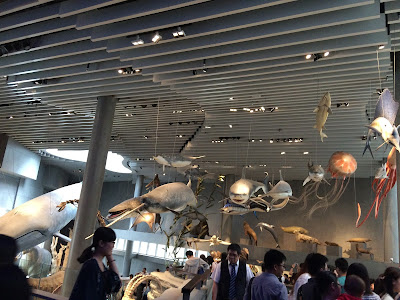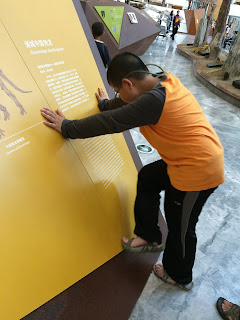Shanghai Natural History Museum
- Aaron
 |
Shanghai Day 4
Shanghai Laoshan Hostel, Shanghai Natural History Museum |
 |
| The entrance |
 |
| The trail of evolution |
Shanghai Natural History Museum had many wonderful things to do. There is an exhibition about the universe at the entrance. The front of the exhibition is a video and explanation of how the universe formed. This place also has fossils and moving models of prehistoric animals. They also have stuffed bodies and living animals. Models show how plants and animals survive in the habitat in a special exhibition.
 |
| Prehistoric animals a floor underneath |
 |
The T. Rex and (hidden by the fossil
on the right) the Oviraptor
|
 |
The 4-D movie
(very realistic)
|
The prehistoric animals were very interesting because of the models. Petrified tree trunks were inside the museum. A woolly mammoth stood right beside a Spinosaurus. A sauropod’s long neck moved from the left to the right and back, as though grazing different trees. The T. Rex tossed its head, moved its arms (same size as adult arms, though they looks puny on a T. Rex), and the tail went back and forth every few minutes. An Oviraptor lay on the nest nearby. It constantly moved its head and made a squawking noise. Although the name means ‘egg thief’ (scientists thought it was stealing eggs the first time a fossil was found), the Oviraptor actually protected its nest and didn’t steal eggs. The earliest fossils here go to the Permian, when animals first started living. The 4-D movie inside was also very awesome.
 |
| Petrified wood |
 |
When did the sea animals start flying
(actually, they're just hung)
|
 |
| A lot of beetles |
The animals were interesting with lots of facts. Sharks, jellyfish, dolphins, fish, squid, and whales were hung from the ceiling. Models of turtles, horseshoe crabs, and giant salamanders lay on the floor. Stuffed birds of all types stood on rocks or the ground, and one was even flying in the air! Deer, moose, elk, yak, bison, the bear family, and the cat family decorated the sides of the walkway. A timeline showed which plants and animals appeared when. Living snakes, skinks, and tarantulas lived in glass cases.
 |
| The survival of organisms |
 |
A pangolin in ball form
(with a predator nearby)
|
The exhibition on how organisms survive told us many things on how they live. Crocodiles get their food, water birds, by pretending to be a piece of driftwood and gradually sinking downward until the prey moves to its mouth. Carnivorous plants attract insects with things they like, then start digesting. Owl feathers have soft hairs that give them the ability to fly silently. Pangolins can curl up into a ball of keratin armor to protect themselves from predators. The Black Heron feeds by canopy feeding. It spreads its wings and makes shade in the water, luring fish to feed on.
 |
The screen glowing white is
the design of a telescope
|
The Shanghai Museum contains many amazing exhibits. The universe exhibit has the history of telescopes from the simple 2 lenses and a tube to the huge ones today. It also includes the origin of everything, or the Big Bang. Fabulous prehistoric creatures are everywhere in all sorts of forms. The animal showcase has many fantastic things inside. The life of organisms are explained in their exhibition. I want to go to this museum again in the future.
 |
Dino facts and a section of the fossil's model
|













No comments:
Post a Comment